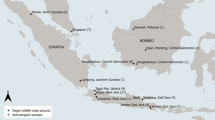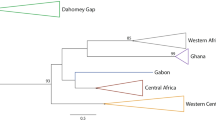Abstract
Four species of iguanas occur in Galápagos. All of them are included in the red list of the International Union for the Conservation of Nature and are protected under the Convention on International Trade in Endangered Species of Wild Fauna and Flora. In Ecuador, attempting to remove wildlife from the Galápagos Islands is a serious environmental crime, punishable under Articles of the Ecuadorian Criminal Code. On July 2012, a tourist was arrested in Galápagos while trying to illegally transport four iguanas out of the province. The four iguanas, confiscated by the authorities of Galápagos National Park, needed rapid taxonomic identification and determination of geographic origin for the purposes of repatriation. The phylogenetic analysis of the Cytochrome b sequence data contributed to the unequivocal molecular taxonomic identification of the four confiscated iguanas, each of which belonged to the species Conolophus subcristatus. The genetic data unambiguously indicated that the four confiscated iguanas had been subtracted from the same population, currently distributed in Baltra and Seymour Norte. The use of molecular tools proved crucial for the rapid assessment of the population of origin. Such a rapid assessment was possible because a large genetic database was already available for Galápagos iguanas. It is recommended that genetic programs be developed for the complete genetic characterization of wildlife in Galápagos as well as in other areas of endemism worldwide.


Similar content being viewed by others
References
Alacs EA, Georges A, Fitzsimmons NN, Robertson J (2010) DNA detective: a review of molecular approaches to wildlife. Forensic Sci Med Pathol 6:180–194
Egeland T, Salas A (2008) Estimating haplotype frequency and coverage of databases. PLoS ONE 3(12):e3988. doi:10.1371/journal.pone.0003988
Felsenstein J (1985) Confidence limits on phylogenies: an approach using the bootstrap. Evolution 39:783–791
Gentile G, Snell H (2009) Conolophus marthae sp.nov. (Squamata, Iguanidae), a new species of land iguana from the Galápagos archipelago. Zootaxa 2201:1–10
Gentile G, Fabiani A, Márquez C, Snell H, Snell H, Tapia W, Sbordoni V (2009) An overlooked, pink species of land iguana in the Galápagos. Proc Natl Acad Sci USA 106:507–511
Haken J (2011) Transnational crime in the developing world. Global Financial Integrity (http://www.gfip.org/storage/gfip/documents/reports/transcrime/gfi_transnational_crime_web.pdf). Downloaded on 14 Oct 2012
Hanley TC, Caccone A (2005) Development of primers to characterize the mitochondrial control region of Galápagos land and marine iguanas (Conolophus and Amblyrhynchus). Mol Ecol Notes 5:599–601
Hasegawa M, Kishino H, Yano T (1985) Dating of human-ape splitting by a molecular clock of mitochondrial DNA. J Mol Evol 22:160–174
Hofkin BV, Wright A, Altenbach J, Miller RD, Rassmann K, Snell HM, Snell HL (2003) Ancient DNA gives green light to repatriation of Galápagos iguanas. Conserv Genet 4:105–108
IUCN (2012) IUCN Red List of Threatened Species. Version 2012.1. http://www.iucnredlist.org. Downloaded on 16 Oct 2012
Jobb G, von Haeseler A, Strimmer K (2004) TREEFINDER: a powerful graphical analysis environment for molecular phylogenetics. BMC Evol Biol 4:18. doi:10.1186/1471-2148-4-18
Márquez CM, Muñoz EA, Gentile G, Tapia W, Zabala FJ, Naranjo S, Llerena AJ (2010) Estado poblacional de las iguanas terrestres (Conolophus subcristatus, C. pallidus y C. marthae: Squamata, Iguanidae), Islas Galápagos. Ser Zool 6:25–43 Boletín Técnico 9, Laboratorios IASA I
Rassmann K (1997) Evolutionary age of the Galápagos iguanas predates the age of the present Galápagos islands. Mol Phylogenet Evol 2:158–172
Rassmann K, Tautz D, Trillmich F, Gliddon C (1997a) The microevolution of the Galapagos marine iguana Amblyrhynchus cristatus assessed by nuclear and mitochondrial genetic analyses. Mol Ecol 6:437–452
Rassmann K, Trillmich F, Tautz D (1997b) Hybridization between land and marine iguana (Conolophus subcristatus and Amblirhynchus cristatus) on Plaza Sur. J Zool Lond 242:729–739
Rassmann K, Markmann M, Trillmich F, Tautz D (2004) Tracing the evolution of the Galápagos iguanas: a molecular approach. In: Alberts AC, Carter RL, Hayes WK, Martins EP (eds) Iguanas, biology and conservation. University of California Press, Berkeley, pp 71–83
Snell HL, Snell HM, Tracy CR (1984) Variation among populations of Galápagos land iguanas Conolophus: contrasts of phylogeny and ecology. Biol J Linn Soc 21:185–208
Tamura K, Nei M (1993) Estimation of the number of nucleotide substitutions in the control region of mitochondrial DNA in humans and chimpanzees. Mol Biol Evol 10:512–526
Thompson JD, Gibson TJ, Plewniak F, Jeanmougin F, Higgins DG (1997) The CLUSTAL_X windows interface: flexible strategies for multiple sequence alignment aided by quality analysis tools. Nucleic Acids Res 24:4876–4882
Tzika AC, Rosa SFP, Fabiani A, Snell HL, Snell HM, Marquez C, Tapia W, Rassmann K, Gentile G, Milinkovitch MC (2008) Population genetics of Galápagos land iguana (genus Conolophus) remnant populations. Mol Ecol 17:4943–4952
Wiens JJ, Hollingsworth BD (2000) War of the iguanas: conflicting molecular and morphological phylogenies and long-branch attraction in iguanid lizards. Syst Biol 49:143–159
Woram JM (1991) Who killed the iguanas? Noticias de Galápagos 50:2–17
Acknowledgments
We thank the editor and two anonymous reviewers for their valuable criticism. We gratefully thank the Mohamed bin Zayed Species Conservation Fund for financial support to GG. We acknowledge and thank the authorities of the Galápagos National Park Service for their continuous effort in preventing the illegal trade of wildlife in Galápagos.
Author information
Authors and Affiliations
Corresponding author
Rights and permissions
About this article
Cite this article
Gentile, G., Ciambotta, M. & Tapia, W. Illegal wildlife trade in Galápagos: molecular tools help the taxonomic identification of confiscated iguanas and guide their rapid repatriation. Conservation Genet Resour 5, 867–872 (2013). https://doi.org/10.1007/s12686-013-9915-7
Received:
Accepted:
Published:
Issue Date:
DOI: https://doi.org/10.1007/s12686-013-9915-7




